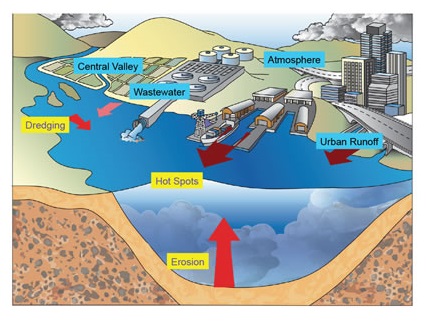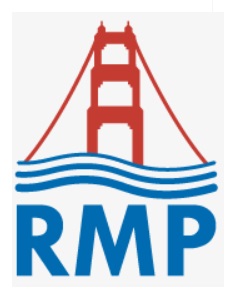Total Maximum Daily Loads (TMDLs)
 |
Total Maximum Daily Loads (TMDLs) are action plans to restore clean water. Section 303(d) of the federal Clean Water Act requires that states identify water bodies -- bays, rivers, streams, creeks, and coastal areas -- that do not meet water quality standards, and the pollutants that impair them. TMDLs examine the water quality problems, identify sources of pollutants, and specify actions that create solutions. They are adopted by the Regional Water Board as amendments to our Region's Basin Plan. |
Announcements
Total Maximum Daily Loads (TMDLs) are action plans to restore clean water by defining how much of a pollutant a water body can tolerate and meet water quality standards. TMDLs account for all the sources of a pollutant, including discharges from wastewater treatment facilities; runoff from homes, agriculture, and streets or highways; "toxic hot spots;" and deposits from the air. In addition to accounting for past and current activities, TMDLs may also consider projected growth that could increase pollutant levels. The San Francisco Bay Regional Water Quality Control Board (Regional Board) is developing more than 30 TMDL projects to address more than 160 listings for water bodies impaired by specific pollutants.
Elements of a TMDL include
Problem Statement: Describes the water body, impaired beneficial uses, and pollutant(s) causing the impairment.
Numeric Targets: Expresses the desired condition of the water body to protect beneficial uses. Defines indicators and associated target(s) necessary to meet numeric or narrative water quality standards.
Source Analysis: Assesses the relative contributions of different pollutant sources or causes and the extent of necessary reductions/controls.
Linkage Analysis: Describes the relationship between numeric target(s) and sources and estimates the ability of the water body to assimilate the pollutant.
Allocations: Allocates responsibility for pollutant reduction. Allocations may be specific to agencies or persons (businesses), or general by source category or sector. The sum of individual allocations must equal the total allowable pollutant level.
Loading Capacity with Margin of Safety: The loading capacity is the amount of the pollutant that can be allowed yet still attaining standards. The margin of safety accounts for uncertainty associated with calculating pollutant loads and their impact on water quality. The margin of safety may be implicit (i.e., through use of conservative assumptions) or explicit (i.e., by assigning a specific allocation to the margin of safety).
Implementation Plan: Details pollution prevention, control, and restoration actions, responsible parties; and schedules necessary to attain water quality standards. Identifies enforceable measures (e.g. prohibition) and triggers for Regional Board action (e.g., performance standards).Monitoring/Re-evaluation: Describes the monitoring strategy that will be used to evaluate the effectiveness of the TMDL and a schedule for reviewing and, if necessary, revising the TMDL and associated implementation elements.
Developing a TMDL involves the following steps:
1. Creating a Project Plan. A project plan describes the water body (or water bodies), pollutant(s), relevant water quality standard(s), and affected beneficial uses; the scope of the TMDL project; the Regional Board's approach; and issues unique to that TMDL. The project plan sets a completion schedule for each step of the process.
2. Developing a TMDL Project Report and an Implementation Plan. A TMDL Project Report describes the water quality problem addressed by the TMDL, details the sources, and outlines solutions. The report includes all the elements necessary for a TMDL (see TMDL Elements). An Implementation Plan describes how and when pollution prevention, control, or restoration actions will be accomplished and who is responsible for these actions.
3. Amending the Basin Plan. The final step in the TMDL process is adopting an amendment to the Water Quality Control Plan for the San Francisco Bay Basin, referred to as the Basin Plan. The Basin Plan amendment is the document that legally establishes a TMDL and specifies regulatory requirements. Basin Plan amendments are adopted through a public process that requires approval by the Regional Board, the State Water Resources Control Board, the California Office of Administrative Law, and the U.S. Environmental Protection Agency.
How long does it take to develop a TMDL?
The process might take four to six years from the beginning of a TMDL project to a Basin Plan amendment. The time required depends on the complexities of scientific and policy issues, the availability of scientific information, and whether additional research studies and data are needed.
How are TMDLs carried out?
Developing TMDLs is only the first step toward solving water quality problems. TMDLs must be carried out to be effective. TMDLs specify a set of actions to improve water quality that can include the following options:
- Enhancing pollution prevention programs for wastewater and urban runoff.
- Cleaning up "toxic hot spots."
- Reducing pollution from agriculture, animal feedlots, septic systems, and marinas.
- Restoring habitat for fish, birds, and other wildlife.
- Working with local governments to create or revise ordinances and other policies.
How can I get involved?
Public participation is a vital part of the TMDL process. Those interested in TMDLs are often referred to as stakeholders. Each TMDL has its own stakeholder process, which can include attending meetings, submitting written comments on draft reports, and reviewing posted items on the Regional Board web site. Sometimes, the Regional Board will seek public assistance with tasks, such as data gathering, data analysis, or public education efforts.
For more information about a completed TMDL, click on the project link.
For more information about a TMDL in development, click on the project link.
- San Mateo County Bay Beaches Bacteria TMDL
- Permanente Creek Selenium
- San Francisquito Creek Sediment
- Stevens Creek Toxicity
- Lake Merritt Advance Restoration Plan Project
The term "303(d) list" is also called "the impaired waters list". This is a state’s list of impaired and threatened waters (e.g. stream/river segments, lakes). States are required to submit their list for EPA approval every two years. For each water on the list, the state identifies the pollutant causing the impairment, when known. In addition, the state assigns a priority for development of Total Maximum Daily Loads (TMDL) based on the severity of the pollution and the sensitivity of the uses to be made of the waters, among other factors. For more information about our region's 303(d) list, please visit our 303(d) list web page.
The Regional Monitoring Program (RMP)
| The Regional Monitoring Program (RMP) monitors pollutant concentrations in water, sediments, and fish and shellfish tissue in the San Francisco Estuary (San Francisco Bay and the Sacramento/San Joaquin River Delta). Many San Francisco Bay Region TMDL Projects use data collected by the RMP. The RMP is a collaboration between the San Francisco Estuary Institute, the San Francisco Bay Regional Water Board, and the region’s regulated discharger community. For more information about pollutant monitoring in the Bay Area, see the Water Board’s Monitoring and Assessment page. |  |
The following links are provided for information only and do not indicate an endorsement by the San Francisco Bay Regional Water Quality Control Board.
Legal Authorities
Clean Water Act Section 303(d) [33 USC 1313. Water Quality Standards and Implementation Plans]
Code of Federal Regulations concerning TMDLs (PDF file)
Government Agency Sites- State of California
State Water Resources Control Board
Federal
National Agricultural Library, Water Quality Information Center - TMDLs
National Fish and Wildlife Service
National Resource Conservation Service(water quality and quantity page)
U.S. Environmental Protection Agency
US. EPA Region 9 TMDL Site (Serving AZ, CA, HI, NV, Pacific Isles, and over 140 Tribal Nations)
EPA-Established TMDLs in Region 9
U.S. Geological Survey
Non-Profits and Trade Associations
Association of California Water Agencies
National Association of Clean Water Agencies ("Evaluating TMDLs; Protecting the Rights of POTWs")
Contact
Setenay Frucht
Setenay.Frucht@waterboards.ca.gov
Phone: (510) 622-2388


